First Published in English.
Location, location, location
The most important factor in consistently catching in the depth of winter is location and my advice at this time of year is to head to a lake you know well and then, if possible, drop into the ‘banker’ swim. You’ve probably heard it a thousand times before, but if you haven’t got fish in front of you, it doesn’t matter if your tackle and bait is the best money can buy, or if you are the best angler in the country, you simply won’t catch.
Today I’m at Brookhall Lake controlled by Colchester Angling Preservation Society, a water I’ve fished for years and it is one of those cruel winters day when there’s been a hard frost, skies and cloudless and to make things worse, a howling chilly wind is blowing. This lake, apart from marginal rushes is relatively featureless to the eye, apart from a set of rushes at the far end of the lake that are situated in open water. Nine times out of ten it contains fish so with no other anglers around, guess where I’m heading? This swim gives me options, open water, reeds on the far bank but most importantly the rushes and this is exactly where I’m going to investigate first.
You can’t beat bread
Bait for the day is simply bread, a bait that seems to be overlooked these days, especially when the tackle shops shelves are full of bright coloured boilies and pellets to choose from, but believe me, bread will catch when all else fails so don’t forget it. Something else worth considering is where the carp are going to be, and take it from me they are rarely if ever laying on the bottom, but more likely to be sat up in the water, in an area that’s slightly warmer, so a popped up bait is a very good option. Air pressure effects at what depth the carp will be but a rule of thumb is the colder it is the lower down they will be. Although it’s raw today, we have had some very unseasonably mild weather recently so I’m guessing that the water won’t be too cold and that the fish will be well off bottom, so I’m going to pop my bait up thirty inches to start with. I do this simply by hair-rigging a punched 8mm disc, taken from the crust, and sandwich this between two discs punched straight from the slice. The hair needs to be quite long as these discs will take on water and fluff up, so don’t go too short. The best way to hair rig these is to use a Push Stop which is tied to the end of the hair, then with a needle inserted pushed through the discs, before twisting and locking the bait on. Push Stops are also great for hair rigging boilies, corn, even worms, so make sure you have some as they are absolutely brilliant.
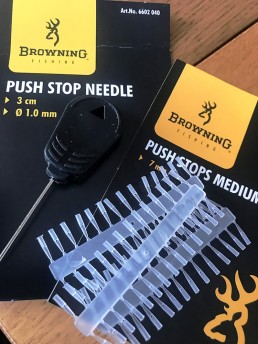
Push stops anchors discs securely on a hair.
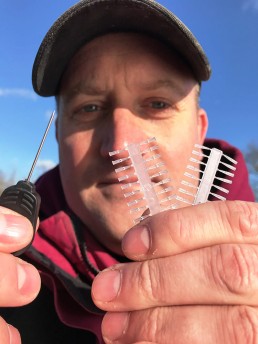
Don’t be without these this winter.
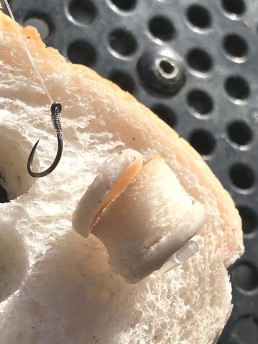
A long hair is essential as the discs will swell up.

The bread swells up in water, filling the hair.
"All you need are a few slices of bread"
Balanced kit equals complete faith
As for the rig, I’m using what’s known as an inline safe system, simply because it gives me the flexibility to change the length of the hooklink, which needs to be done regularly to find where the fish are, or if needed, the size of lead, yet a small semi-fixed inline lead will do the job. As for rod, reel and mainline you have to have complete faith in these, as when fishing close to a feature you need to pile the pressure on instantly and steer the fish into open water. My kit consists of an 11’ CK Method Feeder Rod with the 1oz tip added. This rod has plenty of power in the middle reaches yet the soft tip avoids hook pulls under the rod tip. The reason for using the 1oz tip is it allows me to tighten up to the lead without pulling the rig out of position. This slight tension means that the majority of bites are dropbacks, where the fish has picked the bait up and dislodged the lead, before seeing the tip pull round as the carp bolts. My reel is an 845 Black Viper Compact loaded with either 6lb or 8lb Black Magic Gold Mono depending on the angling situation. As for hook length it’s the ever reliable Cenex Hybrid Power Mono in a 0.18 diameter which has a Sphere CPF LS Barbless Hook tied knotless knot style to produce the hair.
Have a cast around
In the winter, when it’s really cold I don’t put any loose feed in, but simply rely on this visual bait wafting around in the water to gain some interest. Today I’ve started by casting the rig around a rod length off the side of the rushes, as there is no need to go really tight unless you have to. Unfortunately after forty minutes very little has happened, even though I’ve been casting closer and closer to the rushes, however at last, a cast really close has finally produced a bite from a carp around 8lb. I find that it’s worth casting around at first, as often the carp aren’t right in the feature and that a small lead is best as it doesn’t cause too much disturbance. Quite often a bite will come quickly, in the first minute, but if not then you might have to wait up to ten minutes, but once this period is up, it’s time for a recast, slightly further out, or tighter to the feature. Once a carp is caught it’s a good idea to target this spot, yet if things don’t happen, start casting around again to find them. Today the carp are obviously shoaled tight within the rushes, probably due to this cold wind as all my bites have come right up close to the rush stems. Sometimes you just have to go to them, and that’s exactly what I’ve had to do today.
Tim Bruce – Wickford Browning
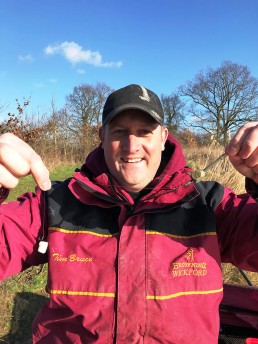
Vary the hooklength to fish at different depths.

Cast around the swim until you find the fish.
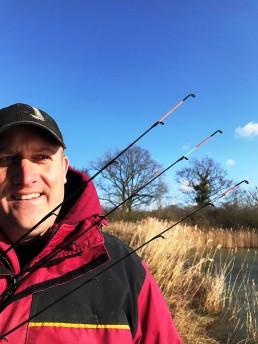
Use a reasonably soft tip as the bites can be quite subtle.

One of many to warm me up on a cold morning.
Tim’s Tackle
CK 11ft Method Feeder
Black Viper 845 Compact Reel
6lb Black Magic Gold Mono
0.18mm Cenex Hybrid Power Mono
Size 14 Sphere CPF LS Barbless Hook
7mm Push Stops and Needle
8mm Bread Punch
2/3rd ounce inline safe system lead
Tim’s Bait
Warburton’s medium sliced toast white bread.
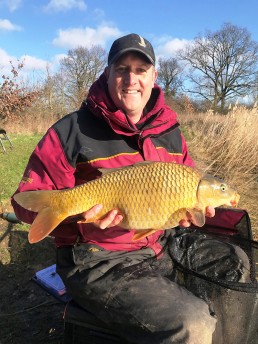
A lovely golden carp brightens up a cold winters day.